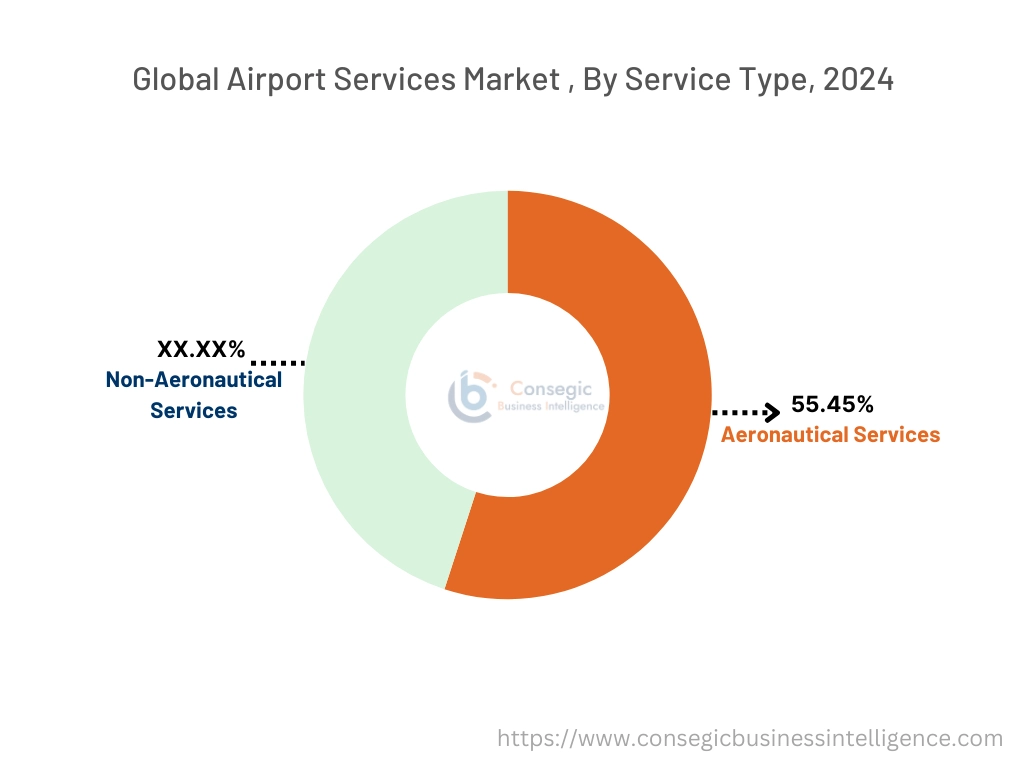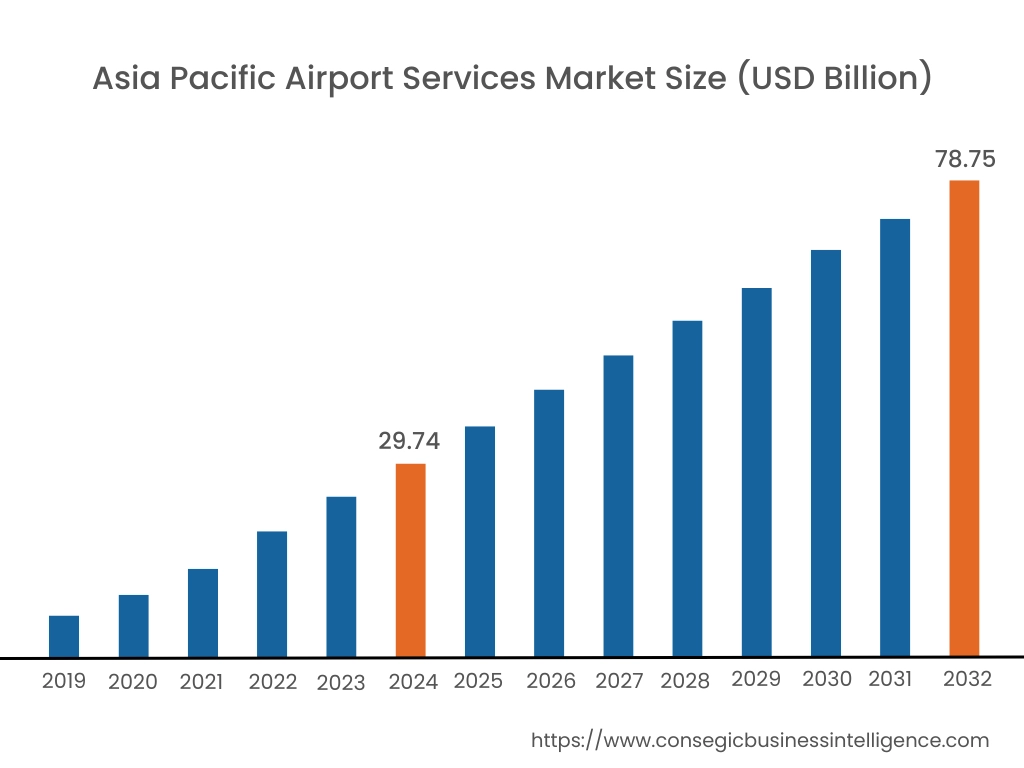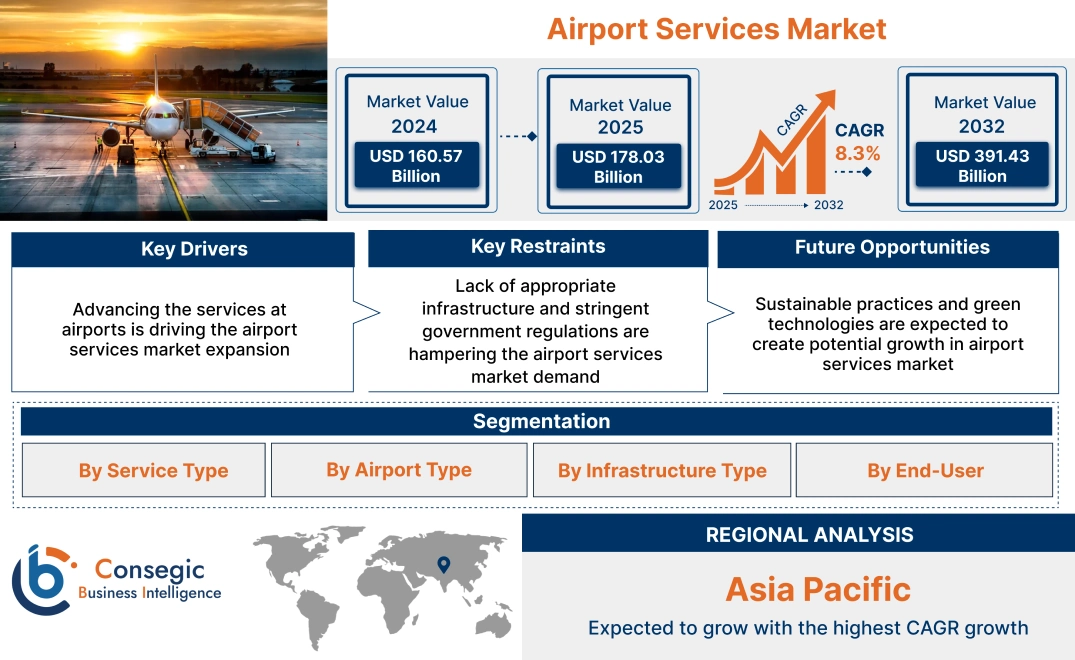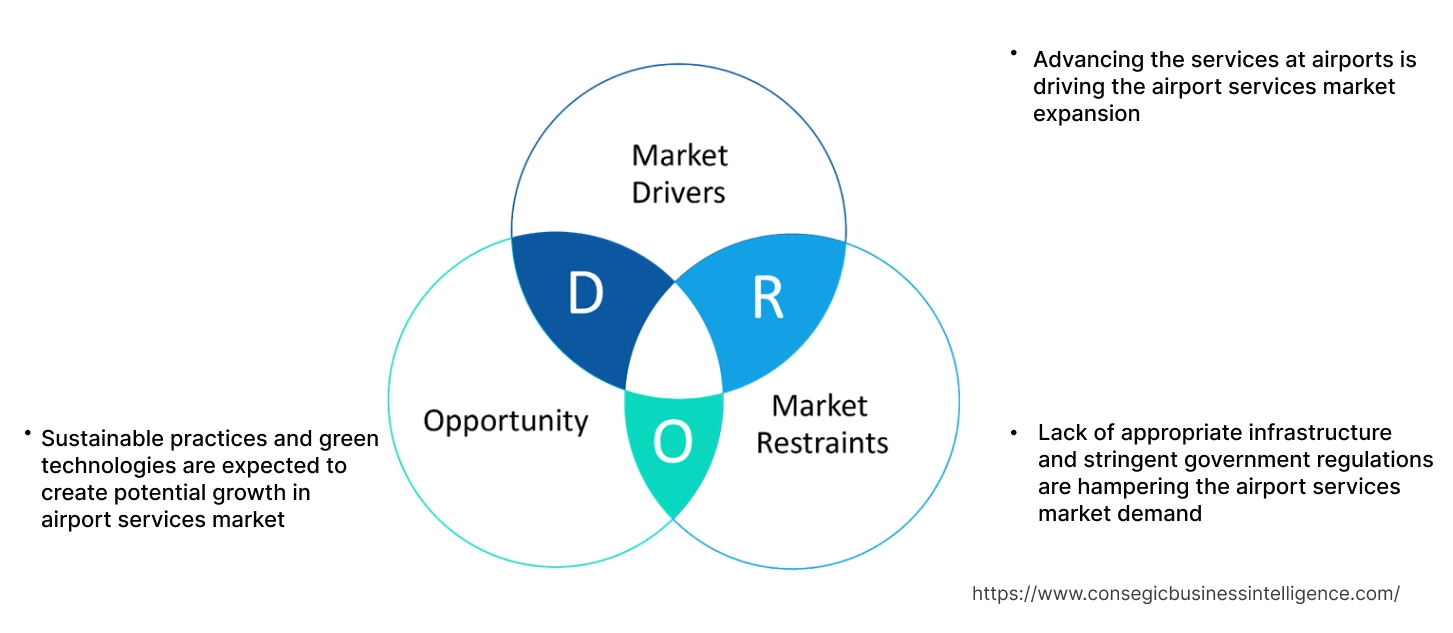- Summary
- Table Of Content
- Methodology
Airport Services Market Size:
Airport Services Market Size is estimated to reach over USD 391.43 Billion by 2032 from a value of USD 160.57 Billion in 2024 and is projected to grow by USD 178.03 Billion in 2025, growing at a CAGR of 10.3% from 2025 to 2032.
Airport Services Market Scope & Overview:
The airport services encompass a broad spectrum of offerings designed to enhance air travel for both passengers and airlines. These services are vital for the safe management of air traffic. The airport authorities guarantee that all processes, from baggage handling to security checks to flight scheduling, function seamlessly. All operations are directed toward a unified goal, to deliver a stress-free and efficient travel experience for passengers. The airport services market is set to experience ongoing development and transformation in the coming years, propelled by several factors including rising air traffic, technological innovations, and a heightened emphasis on passenger experience.
Key Drivers:
Advancing the services at airports is driving the airport services market expansion
The urgent requirement to improve airport infrastructure in smaller cities has resulted in a rise in development projects worldwide. These initiatives focus on enhancing infrastructure and improving the overall customer experience. The construction of new airports is rapidly increasing, with substantial investments directed toward both current and upcoming projects. Additionally, the growing demand for amenities suited for longer routes, modern air traffic control systems, and more gates is expected to further drive the market. Moreover, as airports strive to meet changing passenger expectations and regulatory requirements, investments in infrastructure upgrades and developments will continue to be crucial for improving operational efficiency and customer satisfaction.
For instance, in January 2025, Heathrow Airport has announced plans for a USD 2,862.97 million investment over the next two years, representing the largest private-sector capital investment in the country’s transport network. This upgrade is intended to modernise the country's sole hub airport and international gateway, improving services for both passengers and businesses. The revised investment amount includes an additional USD 303.72 million beyond earlier estimates, with funds designated for enhancements across all terminals. Key initiatives involve upgrading baggage delivery systems and introducing measures to facilitate timely departures and arrivals. The programme aims to enhance service quality, operational resilience, passenger experience, and sustainability at Heathrow.
Thus, according to the airport services market analysis, the growing investment toward advancements in services at airports is driving the airport services market size.
Key Restraints:
Lack of appropriate infrastructure and stringent government regulations are hampering the airport services market demand
Despite the flourishing aerospace sector and ongoing renovations at older airports, certain regions globally continue to face challenges with inadequate infrastructure to accommodate modern aircraft and deliver essential services. The role of government entities, particularly civil aviation ministries, is crucial in managing airport-related services and infrastructure development. Additionally, airports worldwide function under various governance systems, each customized to meet local needs and priorities. This diversity in governance structures highlights the industry's complexity and the necessity for improved cooperation and collaboration among stakeholders to navigate the current crisis and aid the recovery of the aviation sector. These factors are hindering the progress of the airport services market.
Therefore, by improving collaboration among governments, regulatory bodies, airport operators, and industry stakeholders, it is possible to address systemic challenges, optimize processes, and foster sustainable development within the aviation sector.
Future Opportunities :
Sustainable practices and green technologies are expected to create potential growth in airport services market
With the rising global awareness of environmental concerns, there is an increasing demand for airports to reduce their carbon footprint and operate in an eco-friendly manner. Airport operators can leverage this trend by investing in renewable energy sources, such as solar panels and wind turbines, to power airport facilities, thereby decreasing dependence on fossil fuels and lowering greenhouse gas emissions. Furthermore, the adoption of energy-efficient lighting, heating, ventilation, and air conditioning (HVAC) systems can significantly enhance sustainability efforts while also reducing long-term operating costs. Moreover, integrating green technologies into airport operations can improve the overall passenger experience and bolster a positive brand image. Initiatives like recycling and waste reduction programs, water conservation efforts, and sustainable landscaping not only showcase a commitment to sustainability but also appeal to environmentally conscious travelers. By embracing sustainable practices and green technologies, airport service providers can set themselves apart in the market, attract eco-aware passengers, and contribute to the broader objectives of environmental conservation and climate action. This shift toward sustainability not only aligns with corporate social responsibility goals but also positions airports for long-term success in an increasingly environmentally aware.
- For instance, in December 2022, Mumbai International Airport fully transitioned to green energy sources for its consumption, establishing itself as one of India’s 100 percent sustainable airports. Of the total energy requirements, Chhatrapati Shivaji Maharaj International Airport (CSMIA) generates approximately 5 percent of its electricity through onsite solar power, while the remaining 95 percent is sourced from other renewable energies, including hydro and wind. CSMIA was the first airport in India to implement hybrid technology powered exclusively by green energy since April 2022, promoting a highly efficient and low-carbon future for aviation. This sustainable initiative is part of CSMIA's commitment to reducing its carbon footprint and advancing its goal of achieving 'Net Zero' emissions.
Thus, rising adoption of green technologies at international and domestic airports are driving the airport services market opportunities.
Airport Services Market Segmental Analysis :
By Type:
Based on the service type, the market is segmented into Aeronautical Services and Non-Aeronautical Services.
Trends in the Service Type:
- Global economic evolution, rising disposable incomes, and the progression of the middle class in emerging economies are contributing to a significant increase in air travel. This results in higher passenger volumes, more aircraft movements, and an increasing demand for efficient services at the airports.
- Governments and private investors are significantly investing in airport infrastructure worldwide. This encompasses new airport construction, the opening out of existing terminals, and upgrades to facilities.
The aeronautical services segment accounted for the largest revenue share of 55.45% in the year 2024.
- Aircraft maintenance services primarily involve fleet maintenance focused on ensuring the airworthiness of individual components or the entire aircraft. This encompasses regular inspections and repairs, which support market growth, stimulated by an increase in the active fleet size among diverse operators.
- Aircraft ground handling services, a vital aspect of aeronautical services, encompass various tasks such as parking assistance, ramp operations, lavatory cleaning, and others. These services are critical for the smooth functioning of airports and for ensuring efficient turnaround times for aircraft between flights.
- Similarly, passenger services within the aeronautical sector include a broad range of offerings such as transit assistance, security services, and other passenger-focused amenities, including catering, luggage handling, and check-in services.
- These developments would further drive the airport services trends during the forecast period.
The non-aeronautical services segment is anticipated to register the fastest CAGR during the forecast period.
- Non-aeronautical services encompass a wide array of offerings, including car rental, parking facilities, food and beverage outlets, retail shops, and baggage handling services. This segment is expected to experience significant growth, driven by rising consumer demand for ancillary services and amenities within airport environments.
- Non-aeronautical revenue streams offer crucial supplemental support to airport service providers, especially during economic downturns or global crises such as pandemics.
- In August 2024, The Veer Savarkar International Airport, Port Blair, India launched an advanced automated parking system featuring a CCTV, sensor-based boom barrier, and an automatic ticket dispenser, to provide a seamless parking experience for passengers and visitors. The system will considerably decrease the necessity for manual traffic management and will ensure transparent parking tariffs.
- Thus, based on the analysis and trends these factors and developments at airports are driving the airport services market size during the forecast period.

By Airport Type:
Based on the airport type, the market is segmented into International and Domestic.
Trends in Airport Type:
- The continuous expanding route networks by adding new international destinations to enhance global reach, driven by globalization is creating a need for international travel.
- The growing focus on the enhancement of passenger comfort and convenience through amenities such as lounges, retail, and dining options, is driving the market during the forecast period.
The domestic segment accounted for the largest revenue in the year 2024.
- The rise in the number of domestic passengers in developing countries like China and India is expected to drive the global market.
- With increased investment in domestic airports and infrastructure, along with rising need from various sectors, the domestic segment is projected to maintain its development and progression.
- Therefore, based on the above airport services market analysis, the domestic segment will be dominating the market share.
The international segment is anticipated to register the fastest CAGR during the forecast period.
- Post-pandemic, the international segment is positioned for substantial growth, especially following the global easing of travel restrictions. This development is primarily driven by heightened travel expenditures from middle-class consumers in developing nations.
- The integration of advanced technologies, including artificial intelligence (AI), the Internet of Things (IoT), and big data analytics, is transforming international airport operations and improving the passenger experience.
- The ongoing development and modernization of international airports, driven by the need to manage rising passenger volumes and improve operational efficiency, creates significant opportunities for airport service providers.
- In May 2024, Egis, a global leader in mobility sectors, construction engineering, and consulting, has announced the successful completion of three significant airport infrastructure projects in India: Pune Airport, Lucknow Airport, and Trichy Airport.
- Thus, based on the above analysis and trends such factors are fostering innovation and broadening the market opportunities.
By Infrastructure Type:
Based on the payload capacity, the market is segmented into Greenfield Airport and Brownfield Airport.
Trends in the Infrastructure Type:
- Airports are mandated to lower their carbon emissions by engaging in initiatives such as the Carbon Offsetting and Reduction Scheme for International Aviation and the International Civil Aviation Organization (ICAO). These programs provide a global market-based approach to mitigate international aviation CO2 emissions and maintain their levels. Consequently, these regulations and compliance measures have heightened the necessity for eco-friendly practices within airport facilities.
- Advanced airports implement sustainable construction methodologies by utilizing environmentally friendly materials, including recycled concrete, biodegradable plastics, and bamboo in their buildings and infrastructure. Furthermore, they embrace green strategies such as carbon offsetting, sustainable sourcing, and stakeholder engagement to enhance their sustainability initiatives.
- For instance, Beijing Daxing International Airport in China is a sophisticated airport, which features a starfish-shaped terminal, a rainwater collection and storage system, a geothermal heating system, and a solar energy generation system.
- Thus, based on the above analysis and factors these developments would further supplement the airport services market trends during the forecast period.
Greenfield airport accounted for the largest revenue share in the year 2024 and is expected to register the highest CAGR during the forecast period.
- Green airports are constructed on undeveloped land or are designed with environmental considerations integrated into their operations. Their objective is to minimize the ecological effects of airport activities, such as carbon emissions, noise pollution, waste generation, and water consumption. Additionally, green airports aim to enhance the social and economic advantages of aviation, including regional development, connectivity, and job creation.
- These airports utilize sustainable energy sources, such as solar, wind, and biofuels, to power their operations and facilities. They implement strategies to enhance energy efficiency, encourage water conservation, manage waste effectively, and protect biodiversity. These airports are anticipated to be pivotal in advancing sustainability in the aviation sector and contributing to global initiatives against climate change.
- These factors would further supplement the airport services market trends during the forecast period.
By End User:
Based on end user, the market is segmented into Air Travelers, Airport Authorities, Third Part Service Providers, and Others.
Trends in the End User:
- The airport typically offers lined runways, passenger and cargo depot, and repair facilities. Service providers are currently seeking to establish enduring business and trade partnerships to capitalize on long-term benefits, including the modernization of airport infrastructure.
- Countries across the globe are significantly investing in the modernization of their airport infrastructure to enhance user experience and operational efficiency. Projects such as the Airports Authority of India's investment plans illustrate a wider trend of strategic investments in airport facilities. These initiatives often form part of comprehensive revitalization efforts by governments aimed at countering the disruptions caused by events like the COVID-19 pandemic in the aviation market.
The airport authorities accounted for the largest revenue in the year 2024 and is expected to register the highest CAGR during the forecast period.
- Airport handling service providers are essential for the efficient and seamless operation of airports. These providers offer a variety of services, including ground handling, catering, ramp handling, and aircraft servicing. Ground handling entails coordinating various airport services for arriving and departing aircraft, such as baggage handling, passenger assistance, and aircraft fuelling.
- Catering service providers supply food and beverages for passengers on the ground and in-flight. In addition to this, ramp handling involves the movement and positioning of aircraft on the tarmac, while aircraft servicing encompasses maintenance and repairs.
- Airport authorities are increasingly outsourcing non-core functions to service providers to concentrate on their core competencies.
- Further, airport authorities use improved emergency response capabilities to effectively handle unforeseen events, such as security incidents and natural disasters.
- These factors and analysis would further supplement the airport services market during the forecast period.
Regional Analysis:
The global market has been classified by region into North America, Europe, Asia-Pacific, MEA, and Latin America.

Asia Pacific airport services market expansion is estimated to reach over USD 78.75 billion by 2032 from a value of USD 29.74 billion in 2024 and is projected to grow by USD 33.21 billion in 2025. Out of this, China airport services industry accounted for the maximum revenue share of 30.28%. The COVID-19 pandemic significantly affected the aviation market throughout the Asia-Pacific region. Government-imposed regulations aimed at controlling the spread of the virus resulted in supply chain disruptions, manufacturing plant closures, and labor shortages. The decline in air traffic caused a marked decrease in the need for airport ground handling systems, impeding market growth during this period. Nonetheless, the market demonstrated a robust recovery in the latter half of 2020 as travel restrictions were lifted, leading to an increase in both air passenger traffic and cargo volumes. Airlines are now looking to expand their fleets to accommodate the rising number of travelers and air shipments, which has heightened the necessity for airport ground handling systems to support ground operations. Furthermore, the privatization of airports in developing countries like India and Japan is expected to result in increased investments in advanced ground handling systems to manage the growing passenger volumes. Thus, airport privatization is likely to contribute to airport services market share in the coming years.
- For instance, in September 2023, Celebi India announced that it has started providing ground handling services at Chennai International Airport. Celebi India will offer extensive ground handling services to both scheduled and non-scheduled air operators at the facility's domestic and international terminals.

North America airport services market growth is estimated to reach over USD 147.41 billion by 2032 from a value of USD 61.05 billion in 2024 and is projected to grow by USD 67.63 Billion in 2025. North America's airport infrastructure is experiencing substantial progress and development to meet the region's increasing air travel requirements and economic vitality. Key airports of the country, such as Los Angeles International Airport and Hartsfield-Jackson Atlanta International Airport are going through development projects to handle heightened passenger traffic. According to a report by Airport Council International (ACI-NA), North America's airport infrastructure needs for 2023 exceed USD24 billion. The focus is not limited to major hubs; regional airports are also enhancing connectivity. Furthermore, ACI-NA projects that maintain or expand airport infrastructure in North America will require USD151. 1 billion from 2023 to 2027. Sustainability initiatives, emphasizing eco-friendly designs, energy-efficient facilities, and minimized environmental impact, are increasingly incorporated into extension plans. These combined efforts demonstrate North America's commitment to upholding a world-class airport infrastructure that fosters economic growth and ensures a seamless travel experience for passengers. These factors would further supplement the regional airport services market share during the forecast period.
- For instance, in January 2023, Hobby Airport in Houston announced the launch of 10 new restaurants within the airport. This initiative is projected to generate approximately USD 74 million in revenue and create at least 300 jobs.
As per the market analysis, the progression of the European market can be attributed to a strong regulatory framework and a persistent commitment to sustainability in the region. European airports are actively involved in carbon offset initiatives, and the area has the highest concentration of airports that have successfully received Airport Carbon Accreditation. This voluntary program assesses and recognizes airports' efforts in managing and reducing carbon emissions. Additionally, in Latin America, airports are consistently upgrading facilities and customer service. Low commodity prices, stable GDP growth, and high passenger demand are also key factors that drive the regional market. Furthermore, improvements in airport infrastructure, development of the aviation sector, and trends towards replacing traditional aircraft systems with advanced, efficient alternatives are propelling the regional market. Furthermore, the Middle East is expected to see a significant enhancement in airport ground and cargo handling services because of the development of smart airports.
Top Key Players and Market Share Insights:
The global airport services market is highly competitive with major players providing casino management solutions to the national and international markets. Key players are adopting several strategies in research and development (R&D), product innovation, and end-user launches to hold a strong position in the market. Key players in the airport services industry includes-
- Beijing Capital International Airport Co. Ltd. (China)
- Fraport AG Frankfurt Airport Services Worldwide (Germany)
- Signature Aviation plc (U.S.)
- Tokyo International Air Terminal Corporation (Japan)
- Swissport International AG (Switzerland)
- Air General (U.S.)
- Dnata (UAE)
- Worldwide Flight Services (France)
- Heathrow Airport Limited (U.K.)
- Acciona (Spain)
Recent Industry Developments:
Expansion:
- In August 2022, Telangana, a state in India, intends to revitalize three existing airports and develop three new Greenfield airports. These airports are planned for Nizamabad, Warangal, and Adilabad. The airports in Warangal and Adilabad will be constructed on brownfield (existing) sites, whereas the airport in Nizamabad will be a greenfield project.
- In January 2023 Dnata, a travel services provider based in the UAE, has commenced operations at Zanzibar Abeid Amani Karume International Airport in Tanzania. This initiative was achieved through collaboration with SEGAP and Emirates Leisure Retail. The three companies are expected to provide services for passengers and airlines at the T-3 terminal.
Partnership & Collaboration:
- In October 2023, Guangtai and TCR, two manufacturers of ground support equipment (GSE), have committed to collaborating on promoting green innovation for airport buses. In response to client feedback on their decarbonization objectives, TCR identified affordable pricing, competitive rates, proven technology, reliable partnerships, and timely delivery as essential factors.
Airport Services Market Report Insights :
| Report Attributes | Report Details |
| Study Timeline | 2019-2032 |
| Market Size in 2032 | USD 391.43 Billion |
| CAGR (2025-2032) | 10.3% |
| By Service Type |
|
| By Airport Type |
|
| By Infrastructure Type |
|
| By End User |
|
| By Region |
|
| Key Players |
|
| North America | U.S. Canada Mexico |
| Europe | U.K. Germany France Spain Italy Russia Benelux Rest of Europe |
| APAC | China South Korea Japan India Australia ASEAN Rest of Asia-Pacific |
| Middle East and Africa | GCC Turkey South Africa Rest of MEA |
| LATAM | Brazil Argentina Chile Rest of LATAM |
| Report Coverage |
|
Key Questions Answered in the Report
How big is the Airport Services market? +
Airport Services Market Size is estimated to reach over USD 391.43 Billion by 2032 from a value of USD 160.57 Billion in 2024 and is projected to grow by USD 178.03 Billion in 2025, growing at a CAGR of 10.3%from 2025 to 2032.
Which is the fastest-growing region in the Airport Services market? +
Asia-Pacific is the region experiencing the most rapid growth in the market.
What specific segmentation details are covered in the Airport Services report? +
The airport services report includes specific segmentation details for service type, airport type, infrastructure type, end user and region.q
Who are the major players in the Airport Services market? +
The key participants in the market are Beijing Capital International Airport Co. Ltd. (China), Fraport AG Frankfurt Airport Services Worldwide (Germany), Air General (U.S.), Dnata (UAE), Worldwide Flight Services (France), Heathrow Airport Limited (U.K.), Acciona (Spain), Signature Aviation plc (U.S.), Tokyo International Air Terminal Corporation (Japan), Swissport International AG (Switzerland), and others.


